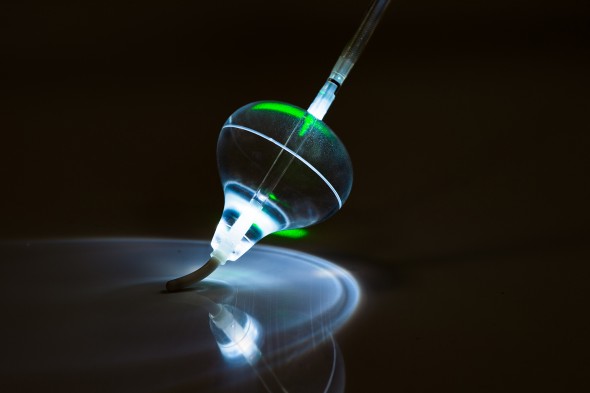Laser, video technology combine in new atrial fibrillation treatment

The visually guided laser balloon of the HeartLight Endoscopic Ablation System. Photo: CardioFocus, Inc.
The University of Illinois Hospital & Health Sciences System is the first hospital in the Midwest to offer an improved minimally invasive treatment for atrial fibrillation, also called AF or AFib.
Pulmonary vein isolation, or PVI, is a first-line treatment for patients whose atrial fibrillation does not respond, or no longer responds, to medication. In PVI, a specialist uses catheters to access the heart and deliver small doses of energy to destroy the tissue that causes the heart to beat irregularly.
The new treatment, performed by an electrophysiologist using the HeartLight Endoscopic Ablation System, uses a laser to destroy the problem tissue, in place of the radio waves used in standard PVI. The laser’s visual guidance provides physicians with a direct view into the heart that was previously unavailable.
The Food and Drug Administration approved the new system a year ago. In early trials, patients experienced similar rates of success as with standard PVI — one study showed 61 percent experiencing freedom from AF at 12 months. But electrophysiologists think that the technology may help improve long-term success rates by creating a more pinpointed and long-lasting therapeutic lesion.
Erik Wissner, director of cardiac electrophysiology at UI Health, has experience using the HeartLight system in Germany, where it was approved in 2009.
He performed the first commercial procedure in the U.S. May 4.
“We are very happy we can offer a new treatment option to our patients,” said Wissner, associate professor of medicine. “Currently, about one-third of patients who undergo PVI will return for a repeat procedure because their AFib comes back. As we study PVI with the visually guided laser, we hope that those numbers may be reduced.”
AF is the most common type of arrhythmia, and the risk increases with age. The Centers for Disease Control and Prevention estimates that up to 6.1 million people in the U.S. have AF, which can lead to an increased risk of stroke. It can also cause chest pain, heart attack or heart failure.
